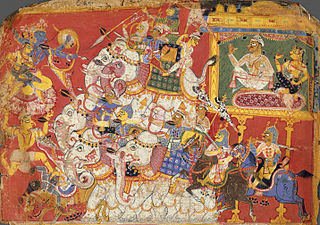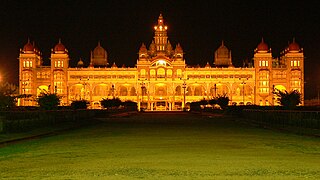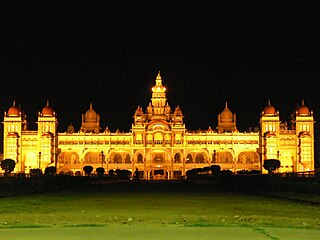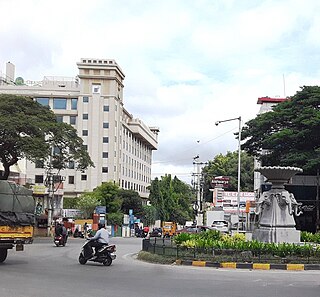
Mysore, officially Mysuru, is the second-most populous city in the southern Indian state of Karnataka. It is the headquarters of Mysore district and Mysore division. As the traditional seat of the Wadiyar dynasty, the city functioned as the capital of the Kingdom of Mysore for almost six centuries. Known for its heritage structures, palaces, and its culture, Mysore has been called the "City of Palaces", the "Heritage City", and the "Cultural capital of Karnataka". It is one of the cleanest cities in India according to the Swachh Survekshan.

Vijayadashami, more commonly known as Dassahra in Hindi-Urdu, and also known as Dashāhra or Dashain in Bhojpuri, Maithili and Nepali, is a major Hindu festival celebrated every year at the end of Durga Puja and Navarahtri. It is observed on the tenth day of the month of Ashvin, the seventh in the Hindu lunisolar calendar. The festival typically falls in the Gregorian calendar months of September and October, more specifically between 27 September and 26 October. It is celebrated on the tenth day of the waxing moon of the Ashvayuja month.

The Surin Elephant Round-up is a cultural festival held every year in Surin Province, Isan, Thailand. Usually the event is organized during the third week of November on the weekend. The festival has its origins in the royal hunts which were conducted in Surin Province during medieval times. The indigenous residents of Surin, the Kuy, have been traditional practitioners of corralling elephants and training them as working animals. When the Ayutthaya Kingdom came into power these hunts were converted into a public extravaganza and wild elephants were replaced with tame ones. The festival, in its contemporary form, was first organized in the 1960s when civil war in Cambodia and the steady decline in economic value of elephants forced the elephant handlers (mahouts) to seek occupations in the entertainment and tourism industry.

The Chamundi Hill is located 13 km east of Mysore, Karnataka, India. The name comes from the Chamundeshwari Temple at the peak. The average elevation is 1,060 metres (3,480 ft).

Mysore Palace, also known as Amba Vilas Palace, is a historical palace and a royal residence. It is located in Mysore, Karnataka, India. It used to be the official residence of the Wadiyar dynasty and the seat of the Kingdom of Mysore. The palace is in the centre of Mysore, and faces the Chamundi Hills eastward. Mysore is commonly described as the 'City of the Palaces', and there are seven palaces including this one. However, the Mysore Palace refers specifically to the one within the new fort.

The Kurukshetra War, also called the Mahabharata War, is a war described in the Hindu epic poem Mahabharata, arising from a dynastic struggle between two groups of cousins, the Kauravas and the Pandavas, for the throne of Hastinapura. The war is used as the context for the dialogues of the Bhagavad Gita.

A howdah, or houdah, derived from the Arabic هودج, which means "bed carried by a camel", also known as hathi howdah, is a carriage which is positioned on the back of an elephant, or occasionally some other animal such as a camel, used most often in the past to carry wealthy people during progresses or processions, hunting or in warfare. It was also a symbol of wealth for the owner and as a result might be elaborately decorated, even with expensive gemstones.

Mysore Dasara is the state festival in the state of Karnataka in India. It is a 10-day festival, starting with nine nights called Navaratri and the last day being Vijayadashami. The festival is observed on the tenth day in the Hindu calendar month of Ashvina, which typically falls in the Gregorian months of September and October.
Balarama was the lead elephant of the Mysore Dasara procession and carried the idol of goddess Chamundeshwari on the fabled Golden Howdah thirteen times between 1999 and 2011. Balarama was a bull born about 1958 and was accompanied in the procession by other Dasara Elephants. Of the many elephants participating, Balarama was one of the star attractions when he carried on his back the sacred idol of goddess Chamundeshwari in the 750 kilograms (1,650 lb) golden howdah on the auspicious 10th day of Dasara celebrations.
Drona was one of the lead Dasara Elephants of the Jamboo Savari of Mysore Dasara. He carried the Golden Howdah for a record 18 years consecutive years between 1981 and 1997, before being electrocuted while grazing in 1998. Of all the carrier elephants since the 20th-century, he is considered the best "because he possessed an excellent ability to learn and correct himself".

The Golden Howdah,'ಚಿನ್ನದ ಅಂಬಾರಿ'(elephant seat or Chinnada Ambari in Kannada) is a howdah, the carrier mounted on the leading elephant during the Jamboo Savari of the famous Mysore Dasara. It is the cynosure of all eyes during the famous Dasara festivities. Since 2020, it has been carried by Abhimanyu.

The Golden Throne or Chinnada Simhasana or Ratna Simhasana in Kannada, was the royal throne of the rulers of the Kingdom of Mysore. It is one of the main attraction of Mysore Palace. It is kept for public viewing only during Dasara festival and on the rest of the days, it is disassembled and kept in safe lockers of the palace.

Bhagadatta was the son of Narakasura and grandson of Lord Shree Adivaraha, and the king of Pragjyotisha in Hindu mythology. Bhagadatta was born from a limb of the asura called Bashkala. He was a renowned warrior, and was known to be a great friend of Indra. When Arjuna embarked on a conquest to help his brother Yudhishthira perform the rajasuya yajna, Bhagadatta was one of the first kings to be conquered by him.

Mysore is a city in the state of Karnataka, India. It is known as the cultural capital of Karnataka. Mysore was the capital of the Wodeyar kings who ruled over the Mysore Kingdom for many centuries. Wodeyars were great patrons of art and music and have contributed significantly to make Mysore a cultural centre. Mysore is well known for its palaces, museums and art galleries and the festivities that take place here during the period of Dasara attract a worldwide audience. Mysore has also lent its name to popular dishes like Mysore Masala Dosa and Mysore Pak. Mysore is also the origin of the popular silk sari known as Mysore silk sari and has also given rise to a popular form of painting known as Mysore painting.

The Mysore Dasara 2013 is the 403rd edition of the annual royal festive gala event, a show of pomp and tradition that is held in the Mysore city in Karnataka, India for 10 days. The festival is called the Navaratri (meaning nine nights or Dussehra or Vijayadashami which conforms to the bright half of the month of Ashvin, from pratipadathithi to navamithithi in the Hindu calendar corresponding to 5 to 13 October during 2013. The festival is also called Nada Habba in Kannada language. The first day of the nine-day festivity started on 5 October with the traditional and religious special puja performed to Goddess Chamundeshwari in the Chamundi Temple on top of the Chamundi Hill, which forms the backdrop to the city; the temple was beautifully decorated with flowers and tourist from Gujarat, Rajasthan and other states enthralled the audience with their bhajan singing. On this occasion, floral tribute wa offered to the goddess by Jnanpith Award winner Chandrashekhara Kambara and festivities will continue for ten days. The ninth day of the festival is a special event called the Mahanavami when the royal sword is worshipped and taken in a procession of elephants, camels and horses. The festival concludes on 14 October on the dashami day with the grand finale of Jambusavari with the idol of Chamundeshawri set in a golden howdah mounted on a richly caparisoned elephant. The procession is taken through the streets of the city and ends in the Banni Mantap where, in the evening, a torch light parade is held. Symbolically, the festival represents the victory of good over evil.

Arjuna was an Asian elephant who, from 2012 to 2019, was the lead elephant and the carrier of the Golden Howdah at the Mysore Dasara. He was named after Arjuna, the third of the Pandava brothers from the Hindu epic Mahabharatha. Arjuna was part of a Karnataka Forest Department to tackle wild elephants across western Ghats of Karnataka and also operated in many states for capturing wild elephants. Arjuna died in combat on 4 December 2023.

Bannimantap is an historical place in the Indian city of Mysore, Karnataka, India. where the world famous Mysore Dasara Jumbo Savari parade marks the end and after which cultural programmes are host every year on Vijayadashami in the presence of the Governor of Karnataka, Chief Minister of Karnataka and other Council of Ministers of the Govt. of Karnataka.

Y. Subramanya Raju was an Indian artist who patronized the Mysore style of traditional art. He was born into a family of court painters in the princely state of Mysore. The Mysore Dasara Procession paintings which adorn the walls of the Kalyana Mantapa in the Mysore Palace are few of his exquisite works. In the later years, Raju involved himself with the Karnataka Chitrakala Parishath for the promotion of fine art and artists in the State. Raju spent most of his years teaching and popularizing Mysore style of art, as a recognition, Emeritus Fellowship was awarded by the Ministry of Human Resource Development and the Government of India gave its National Award for his excellence in Traditional Mysore Painting.

Hanumanthanagar is a locality in Bannimantap, a suburb of Mysore coming on the Northern side of the city. It is part of Mysore district in Karnataka state of India. Hanumanth Nagar is famous for the Jumbo Savari with the golden Howdah, a part of Mysore Dasara, which marks an end of the procession in Bannimantap via Highway Circle of Hanumanth Nagar.


















